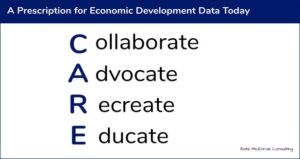 I have been quite open in discussing my concerns about the damage that is likely to be cause by recent policy decisions to the quality and availability of data we all use for community and economic development.
I have been quite open in discussing my concerns about the damage that is likely to be cause by recent policy decisions to the quality and availability of data we all use for community and economic development.
The Dalai Lama has said “If a problem can be solved, there is no use worrying about it. If it can’t be solved, worrying will do no good.”
I don’t claim to know how to solve this problem, but I want to do something other than worry about it, so this is the framework I’ll be keeping in mind, and maybe it will help you too.
Collaborate
Maybe this means collaborate with one another, maybe it means collaborate more with your third party data providers because they aren’t immune from these challenges either. One of the great things about broad data sets is that it allows for comparisons, so perhaps this is an opportunity for co-opetition, for exchanging local data even with places that may be competition.
Advocate
I’ll be taking every opportunity I can to advocate to protect data availability and accuracy. What an opportunity to collaborate – a chorus is always more compelling that scattered
voices. A focus on the perhaps unintended but locally damaging consequences is another way to strengthen the message.
Re-create
Many federal data sources are “fed” from the bottom up, especially those related to workforce. State labor departments, colleges and universities, even think tanks and foundations are primary data collectors and researchers. They can supply data directly and perhaps more quickly that short-staffed agencies, and they can also provide an insight into the accuracy of analyses.
Here’s another idea. Consider localizing these “quirky” metrics and indicators that Forbes says can help create a sense of what is happening in the economy beyond BLS data.
Educate
Let’s face it, those of us that do this work are data nerds and we know why we need this information, but not everyone else does. Few people in the community, even those who consider themselves direct stakeholders in economic development, appreciate the decisions that are made or not made based on workforce numbers, economic performance numbers, and quality of life indicators. Fewer still have the direct experience to understand that having confidence in the information is as important as the information itself.
OK, that’s what I have so far.
